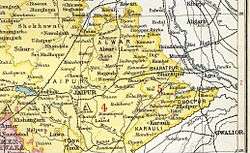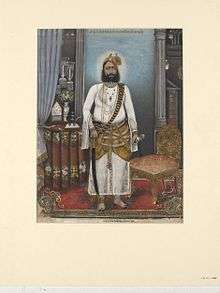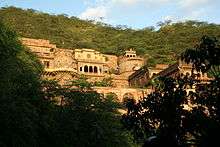Alwar State
| Alwar State अलवर रियासत | ||||||
| Princely State of British India | ||||||
| ||||||
| ||||||
 | ||||||
| History | ||||||
| • | Established | 1770 | ||||
| • | Independence of India | 1949 | ||||
| Area | ||||||
| • | 1895 j | 8,547 km2 (3,300 sq mi) | ||||
| Population | ||||||
| • | 1895 j | 682,926 | ||||
| Density | 79.9 /km2 (206.9 /sq mi) | |||||
| Today part of | Rajasthan, India | |||||
Alwar State was a princely state with its capital at Alwar ruled by a Kachwaha Rajput dynasty during the period of the British Raj in India. Founded in 1770 CE by Pratap Singh Prabhakar, its last reigning ruler, H.H. Maharaja Sir Tej Singh Prabhakar Bahadur, signed the accession to the Indian Union on 7 April 1949.[1]
History
Alwar has been a part of Matsya region of olden times whose capital was Viratnagar. Alwar was formerly known as 'Ulwar'. Meenas are said to have been the first occupants of Alwar. They are said to have built the fort and the old town, remains of which last are to be seen within the hills under the fort. In the fourteenth century Bahadur Raja Nahar Khan won Alwar from Nikumba Rajputs, after which Alwar became the capital of the Khanzada Rajput dynasty's Mewat State, which was established by Chandrawanshi Rajput Raja Nahar Khan, who converted to Islam in the fourteenth century during Firuz Shah Tughlaq's era. Khanzada Hasan Khan Mewati was the last Khanzada Rajput Ruler of Mewat who fought against Babar in the Battle of Khanwa. After his defeat in the battle, the Khanzada lost control of Mewat. After the Battle of Khanwa, Alwar was won over by the Jats. It later came under Kachwaha rajputs in 1770 CE.
Pratap Singh, Thakur of Macheri, became a distinguished soldier of fortune in the Jaipur State Forces, who eventually entered the Imperial service. He gained many victories against the Jats, receiving Imperial recognition of dominion over some of the territories he conquered. He established an independent Alwar state in 1770, and assumed the title of Maharao Raja of Alwar after successfully conquering the famous fort of that name. Alwar State remained a semi-independent princely state until the Partition of India.
Following the Partition of India in 1947, Alwar acceded unto the dominion of India. On 18 March 1948, the state merged with three neighbouring princely states (Bharatpur, Dholpur and Karauli) to form the Matsya Union. This union in turn merged unto the Union of India. On 15 May 1949, it was united with certain other princely states and the territory of Ajmer to form the present-day Indian state of Rajasthan.[2]
Jai Dayal Yadav, along with Prime Minister of Matsya Union Shobha Ram Kumawat, played a vital role in bringing education to the rural areas of Alwar after independence.
Rulers of Alwar state

- Matsya Meenas Dynasty
- Nikumba Rajputs
- Khanzada Muslim Rajputs till the 16th century as part of Mewat State.
- Jats till 1770
- Partap Singh (1770-1791) Raja of Alwar
- Bakhtawar Singh Prabhakar (reign: 1791–1815), Raja of Alwar.
- Bane Singh Prabhakar (reign: 1815–1857), Raja of Alwar.
- Sheodan Singh Prabhakar (reign: 1857–1874), Raja of Alwar.
- Sir Mangal Singh Prabhakar (reign: 1874–1892), Maharaja of Alwar.
- Honorary Colonel Sir Jai Singh Prabhakar (reign: 1892–1937), Maharaja of Alwar.
- Colonel Sir Tej Singh Prabhakar (reign: 1937-1947), the last reigning Maharaja of Alwar. Sir Tej Singh remained the titular or nominal Maharaja up until his death in New Delhi in February 2009.
- Jitendra Singh, the current nominal Maharaja of Alwar (since February 2009).
Legends
It is said that His Highness Maharaja Sir Jai Singh Prabhakar visited the Rolls-Royce showroom in London in 1920. He was neglected by the salesmen. Incensed, he bought six cars, brought them to Alwar, and used them for sweeping the streets.[3]
Relics
The Alwar City Palace, or Vinay Vilas, built in 1793 by Raja Bakhtawar Singh, is now a district administrative office.[4]
See also
References
External links

- Indian Durbar (1938) - filmed in Alwar


